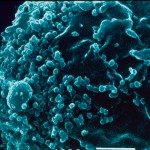Link to Pubmed [PMID] – 2479543
EMBO J. 1989 Nov;8(11):3279-85
The virion cores of the replication competent type 1 human immunodeficiency virus (HIV-1), a retrovirus, contain and RNA genome associated with nucleocapsid (NC) and reverse transcriptase (RT p66/p51) molecules. In vitro reconstructions of these complexes with purified components show that NC is required for efficient annealing of the primer tRNALys,3. In the absence of NC, HIV-1 RT is unable to retrotranscribe the viral RNA template from the tRNA primer. We demonstrate that the HIV-1 RT p66/p51 specifically binds to its cognate primer tRNALys,3 even in the presence of a 100-fold molar excess of other tRNAs. Cross-linking analysis of this interaction locates the contact site to a region within the heavily modified anti-codon domain of tRNALys,3.
